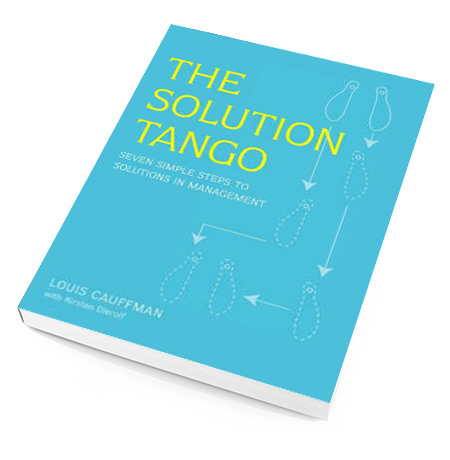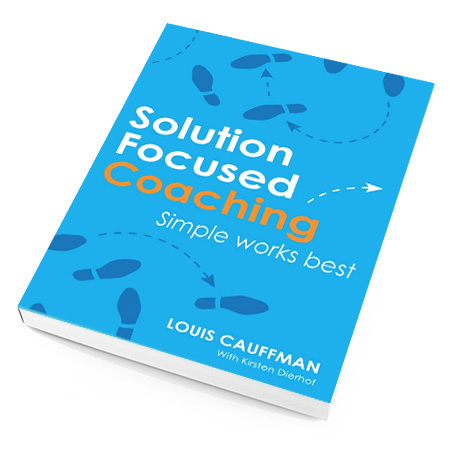Episode 7 – The Man in the Middle: A Solution Focused Feuilleton
Steve: “You are getting there, Peter, congratulations. So, you’re saying that the fact that John has at least left you alone, that the management has entrusted the dismantling to you, and that the two of us are now working on a constructive solution is worth a two. Excellent! I know the past few months have been difficult for everyone — no one has yet processed the merger fully, and there are still problems with the personnel changes. This hasn’t made work easier. Nevertheless, I have to congratulate you on the fact that you have continued to work in your trusted and persistent way.”
Peter is a bit overwhelmed by Steve’s consistently positive attitude, but he cannot deny the truth of Steve’s statements. You may have noticed that Steve put the problem in a broader context: the merger has still not been processed completely, there have been many personnel shifts, the atmosphere and corporate identity have changed, John’s management style, the general uncertainty within the entire company, and the fact that there were no clear responsibilities or authorities defined for the enormous dismantling project. Steve doesn’t view these elements as explanations for the problem but rather as tools that he will use in a later stage of the intervention to steer things toward a solution. In Steve’s approach there is no room for analyzing the root causes of the problem. Furthermore, Peter admits that he has made twenty percent progress compared to last week!

Steve: “OK. It might be too early to find out what could be the next small step forward. Therefore, if you agree, I would like to give you an assignment you can think about in the coming week. You know that even in the midst of a mess, there are always things that still function well. Think about which aspects of the company, yourself, and your col- leagues are so important to you that you would definitely want to keep them. Continuation question Whatever you feel is still working, big or small, interests me. I would like you to write down those things. We’ll discuss them in our next meeting.”
The continuation question focuses Peter’s attention on what still works in spite of the problem. It will probably help Peter to step out of his problem-oriented fixation. By indicating that even little details can be important, it is made clear to Peter that no major changes are demanded from him.
The assignment is failsafe: even if he does not do it, it is highly likely that, at the very least, he will think about it for some time.
As you have noticed during this first session, no emphasis at all is put on analyzing the causes of the problem or on trying to explain the solution-focused model. On the contrary, it’s “just a conversation’’.
Steve does not tell Peter what to do. On the contrary, the use of questions invites the gradual development of a different way of thinking about the problem. The sequence of the solution-building questions is carefully designed by Steve. Peter’s answers lay the foundations for alternative possibilities to come from him. This elegant and unobtrusive method directs Peter step by step towards the solution-focused approach. Steve is leading Peter from behind.
Steve: “You know that even in the midst of a mess, there are always things that still function well. Think about which aspects of the company, yourself, and your col- leagues are so important to you that you would definitely want to keep them. Whatever you feel is still working, big or small, interests me. I would like you to write down those things. We’ll discuss them in our next meeting.”
Meeting 2
The second meeting with Peter has a very different atmosphere to it. Peter is more cheerful, has loosened up a bit, and even before the meeting starts, he mentions that he has made some progress in his plan for the dismantling project. These positive changes are not uncommon when you use the solution-focused method. Once people have been able to avert their fixation on problems, positive signs turn up (seemingly) automatically.
Steve: “OK, Peter, according to what you just told me in the hallway, it looks like you have made a lot of progress. That’s good. For a start, let me ask you a question: ‘What have you done well and what was difficult?’”
It is very useful to start second and further meetings in solution-focused coaching with this question. It is designed in a special way. In the first part you ask your client what it was that he or she actively did well. This implies that everything that went OK is the result of activity from the side of the client.
The second part of the question is phrased as if the client just undergoes the difficult things, without being responsible for them.
This double-sided question gives your client the possibility to choose which part he wants to answer first. It shows the client that we allow him to talk about both positive and negative matters. Working solution- focused does not mean that we are problem-phobic! Whatever the client chooses, we accept and build upon it. When the client chooses to answer the second part, you let him talk and, by asking solution-building questions, see if you can find exceptions or resources in his answers. Then you move on to the first part of the question, which of course is a lot more interesting.
If the client prefers to first talk about the good things, you encourage him and expand on the positive things he tells you. It’s useful to dig into the details of all the useful answers that you get. Often the client wants to talk about the second part and then you proceed as mentioned above. Sometimes, this question just sets the client in the solution-focused direction and you can quickly take the next step, as in the case of Peter.
Peter: “What I’ve done well? I don’t know but I do know that this thing with John is still happening. He avoids me but at the same time I have the impression that he takes every opportunity to talk to my employees when I am not around. As for the rest, I told you, I decided not to bother too much about him. I keep myself focused on the preparation of the dismantling project. I must say I feel a lot better since I am back into such a big project. I was tired of having to bother with small insignificant ones.”
Steve: “Very good. How did the assignment go?”
Peter: “Well, I certainly would like to keep my job in this company. The work in the project department used to go smoothly and, in the past, we proved that we can be successful. Solteam. might not be the company it used to be, but in life things change. Same goes in our business.”
Steve is pleased with these answers. They indicate that Peter sees exceptions to the problem and that he accepts that limitations exist for which no solution is feasible. Peter also expresses his commitment to the company. Steve, of course, doesn’t begin jumping up and down with joy — this answer isn’t the ultimate solution. It is, however, the start of solution- orientation in Peter.
Steve: “Perfect. Where are you now on the same scale from zero to ten where zero stands for ‘this won’t work’ and ten stands for ‘I am convinced that this will turn out well’?”
Notice that, despite the words “the same,” this scale is actually different from the first one! The current scale has more to do with the belief that positive change is possible than with assessing how things are now.
Peter: “I think I am at a four. I have made a lot of progress with the preparation of the dismantling. John called me just yesterday to hear how things are going and, miracle of miracles, he just listened without criticizing! By the way, last Monday night our team went out for drinks because it was someone’s birthday. We hadn’t done that for a long time and it was very pleasant. Even the newcomers went along and it was just fun. We should do it more often.”
Steve: “Very good. What else?”
Peter: “Nothing. There are still a lot of times when I have doubts and think it will never work out. I am afraid that this improvement is just a temporary thing.”
Steve doesn’t ask about the meaning of the four but simply allows Peter to explain about the change. Steve goes on with the “what else” question that is useful for eliciting more details. Nothing interesting follows and Steve does not insist. He listens to Peter’s doubt without being tempted to give him a pep talk. It’s time for the next step. When you look at the flowchart, you will see that Peter is still in the searching position: his request for help is too vague to be workable. As we have seen on page 101, the miracle question is a great tool to help him rephrase his goals in more concrete terms. Using the protocol on page 106 helps to ask the miracle question in the most useful way.
Steve: “Good. Can I ask you a strange question? It is about miracles.
(to be continued)
Already read the upcoming episode 8
Back to episode overview
‘The Man in the middle’ is an excerpt from the book ‘The Solution Tango’ (and ‘Solution Focused Coaching’ e-book) by Louis Cauffman. This book presents a new approach to conquering the numerous challenges, problems, and failures that managers encounter at work, many of which are people-related. An important lesson identified in the book is that a manager must act as both the leader who provides direction for a team or company and as the coach who enables others to make the most of their skills, enabling the individual and the organization to succeed. A seven-step framework to enhance problem-solving capabilities, examples and tips, and a survival kit for sinking managers will help managers improve their people skills and learn how to approach everyday issues from a positive perspective.
 LOUISCAUFFMAN.COM
LOUISCAUFFMAN.COM
